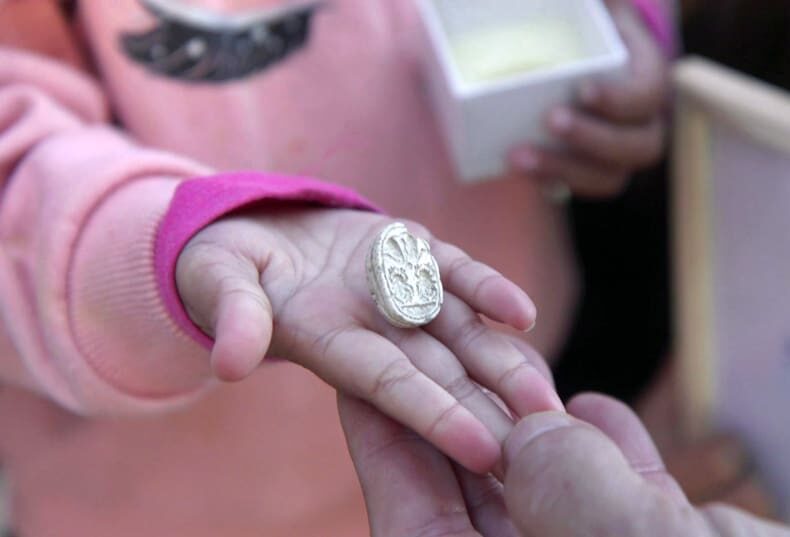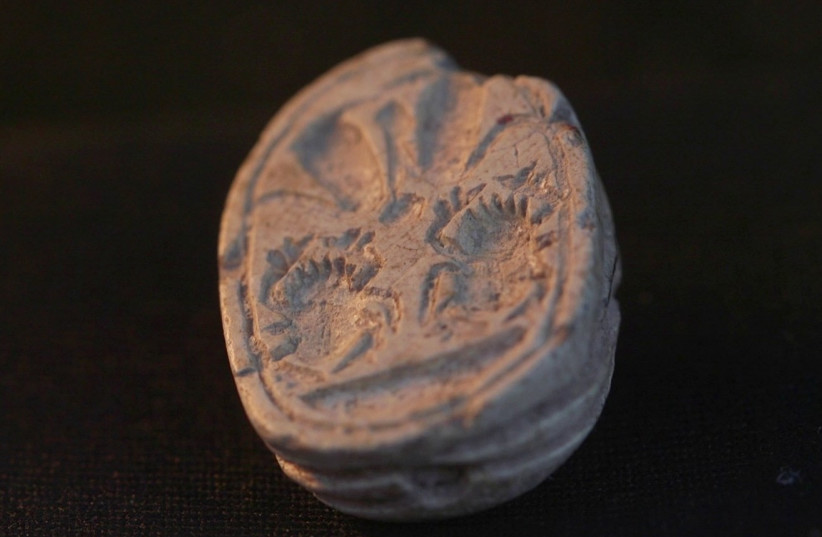
A 3.5-Year-Old Girl Discovers 3,800-Year-Old Scarab Amulet in Israel
Little Ziv Nitzan, from Moshav Ramot Meir, might have just started her archaeology career after finding a 3,800-year-old amulet with an ancient Canaanite seal during a family trip to Tel Azeka, near Beit Shemesh.
“We were walking along the path, and then Ziv bent down – and out of all the stones around her, she picked up this particular stone,” recounts Omer Nitzan, Ziv’s sister. “When she rubbed it and removed the sand from it, we saw something was different about it. I called my parents to come see the beautiful stone, and we realized we had discovered an archaeological find! We immediately reported this to the Israel Antiquities Authority.”
Her discovery was greatly appreciated by archaeological authorities. Semyon Gendler, Judah Region District Archaeologist on behalf of the Israel Antiquities Authority (IAA), awarded Ziv with an appreciation certificate for “good citizenship” and thanked the family for reporting the find.
This ancient discovery will be on special display over the Passover holiday at the Jay and Jeanie Schottenstein National Campus for the Archaeology of Israel, alongside other discoveries from the same period, many of which are being displayed for the first time.
Initially, little Ziv picked up what she thought was a stone. Instead, it was an amulet from the Middle Bronze Age. According to Dr. Daphna Ben-Tor, an expert in ancient amulets and seals, the seal was a Canaanite scarab. “Scarabs were used in this period as seals and as amulets. They were found in graves, in public buildings and in private homes. Sometimes they bear symbols and messages that reflect religious beliefs or status,” Ben-Tor said of the discovery.

Scarab seals are tiny, ornate objects originally from ancient Egypt. They are designed in the shape of a dung beetle, which, according to the IAA, had symbolic meaning. This specific type of beetle was considered sacred in ancient Egyptian society and was symbolic of the incarnation of their creator.
The discovery was found at Tel Azeka, an archaeological site near Beit Shemesh. The area shows evidence of cultural changes in the region throughout history. Discoveries at the same place by a Tel Aviv University excavation team included city walls and agricultural installations from the days of the Judahite Kingdom.
Tel Azekah was also known as a key feature in the biblical battle scene between David and Goliath, as described in the Book of Samuel (Samuel I 17:1).
“We have been excavating here for almost 15 years, and the excavation findings show that during the Middle Bronze and Late Bronze Ages, here in Tel Azekah, thrived one of the most important cities in the Judean Lowlands,” said Prof. Oded Lipschits, director of the Tel Aviv University archaeological dig.
Lipschits met Ziv’s family at the ancient tel. “The scarab found by Ziv joins a long list of Egyptian and Canaanite finds discovered here, which attest to the close ties and cultural influences between Canaan and Egypt during that period,” she added.
Israeli Heritage Minister Amichai Eliyahu commented on the discovery. “The seal that little Ziv found during a family trip to Tel Azekah connects us to a grand story, that of the ancient civilizations that lived in this land thousands of years ago,” he said. “The scarab Ziv found also reminds us that in the Land of Israel, even children can be a part of discovering history.”
Cover Photo: EMIL ALADJEM/ISRAEL ANTIQUITIES AUTHORITY
You may also like
- A 1700-year-old statue of Pan unearthed during the excavations at Polyeuktos in İstanbul
- The granary was found in the ancient city of Sebaste, founded by the first Roman emperor Augustus
- Donalar Kale Kapı Rock Tomb or Donalar Rock Tomb
- Theater emerges as works continue in ancient city of Perinthos
- Urartian King Argishti’s bronze shield revealed the name of an unknown country
- The religious center of Lycia, the ancient city of Letoon
- Who were the Luwians?
- A new study brings a fresh perspective on the Anatolian origin of the Indo-European languages
- Perhaps the oldest thermal treatment center in the world, which has been in continuous use for 2000 years -Basilica Therma Roman Bath or King’s Daughter-
- The largest synagogue of the ancient world, located in the ancient city of Sardis, is being restored











Leave a Reply